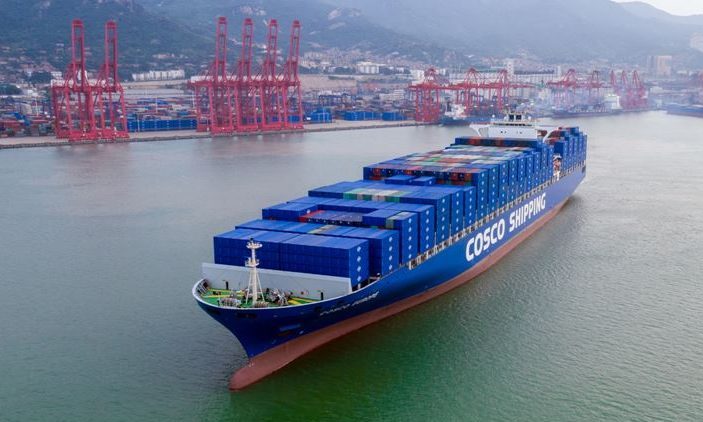Liners still unable to offer uniform CO2 calculations

Shippers keen to cut their CO2 footprint ought to ship with COSCO, China’s largest maritime conglomerate. The reason is nothing to do with COSCO’s vessels, rather its questionable online CO2 calculator.
Container shipping has been castigated for years over its inability to provide accurate CO2 emissions per container shipped.
Putting the issue in sharp relief, Lars Jensen, CEO of liner consultancy Vespucci Maritime, via LinkedIn yesterday, took the Ocean Alliance’s service from New York to Shanghai.
All four Ocean Alliance carriers, Evergreen, CMA CGM, COSCO and OOCL, have an online CO2 footprint calculator. If a customer books with any of these, the cargo will go on the exact same vessel on the exact same routing.
CMA CGM shows the emissions from New York to Shanghai as 1370, 1770 or 1779 kg of CO2 depending on which of the three different services selected. CMA CGM states it uses the Clean Cargo Work Group (CCWG) methodology. CMA CGM specifies it uses the well-to-wake methodology and a 70% utilisation factor in accordance with the revised methodology of CCWG.
Evergreen’s calculator forces customers to choose a service name but the service names do not match the service names in their scheduling tool. Choosing Evergreen’s two North Asia – US East Coast services provided the information that the footprint is 809 or 839 kg of CO2 depending on service. The Taiwanese carrier states on its site: “We have developed a CO2 calculator to provide our partners who care about environmental issues and work with us in energy saving a valuable tool to estimate their carbon foot print (g-CO2/TEU) on Evergreen’s major routes.”
OOCL, meanwhile, shows the emission as 692kg of CO2 using the ECX2 service. OOCL states on its site: “The vessel data is collected from actual emissions figures from OOCL ships. The land-based intermodal data is collected from the Clean Cargo Working Group and OOCL’s regional office operations management, as well as publicly available sources.“
COSCO stands out for its green offering, showing the lowest emission at 437, 516 or 533 kg depending on the service chosen.
COSCO states: “COSCO Shipping Lines has provided an advanced dynamic carbon emissions calculating system faced to global customers, which is implemented based on actual dynamic data of COSCO Shipping Lines-operated vessels.”
“In essence a shipper, who actually believes these numbers, could dramatically reduce their CO2 footprint in their own environmental reporting by switching from CMA CGM to COSCO. Which of course would amount to no CO2 change at all as the cargo will move on exactly the same vessel,” Jensen observed in a widely read post on LinkedIn, going on to suggest that the shoddy, non-uniform CO2 calculators that have been an issue for shippers for many years create an opportunity for forwarders to develop their own calculators to at least compare directly across carriers.
A report from Copenhagen analysts Sea-Intelligence published in December 2019 branded existing carrier CO2 calculators as “useless”, pointing out that shippers could reduce their CO2 footprint by 77% by switching from one carrier to another even though, like Jensen’s example above, the container would move on the same vessel as both carriers are part of the same alliance.

Greenwashing at its illogical, disingenuous best.
Your 2019 piece captured the industry’s effort best with you can save close to 80% of the CO2 emitted by “just changing the color of the box aboard.”